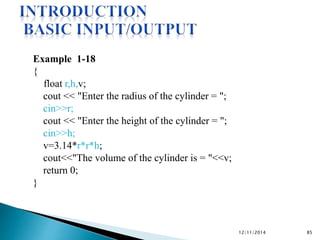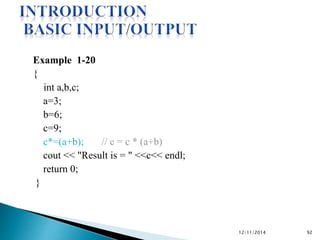Programming Fundamentals
- 1. #include<iostream.h> using namespace std; int main ( ) { int r; float p, peri; r = 2; p = 3.14; peri = 2*p*r; cout<<“Result is = “<<peri<<endl; return 0; } 12/11/2014 1
- 5. CS-211 PROGRAMMING FUNDAMENTALS Introduction 12/11/2014 5
- 6. C++ (See plus pluss) To follow syntax and rules of Turbo C++ and Borland C+ Text editors e.g. WordPad and note pad These are used to write the code Compilers are used to run the code Source code written and stored in first.cpp Compiled code stored/saved as first.obj Executed code stored as first.exe 12/11/2014 6
- 7. Contains following three parts ◦ Preprocessor directives ◦ The main( ) Function ◦ C++ statement 12/11/2014 7
- 8. Preprocessor Directives Instructions given before beginning of actual program Also called Compiler Directives To define certain actions or special instructions (include arithmetic equation) Normally begin with number sign (#) May include keywords like “include” or “define” 12/11/2014 8
- 9. Example 1-01 #include<iostream> int main( ) { cout <<“this is my first program”; return 0; } 12/11/2014 9
- 10. Example 1-01 (output) 12/11/2014 10
- 11. Preprocessor Directives Header file C++ source file Contains definitions of function/objects “include” is used to add “iostream” into the program Has Large number of header files in which library functions are defined 12/11/2014 11
- 12. Example 1-01 #include <iostream> using namespace std; int main ( ) { cout <<“this is my first program”; return 0; } 12/11/2014 12
- 13. Example 1-01 (output) 12/11/2014 13
- 14. Example 1-01 #include<iostream.h> #include<conio.h> void main( ) { cout <<“this is my first program”; getch( ); } 12/11/2014 14
- 15. Header file “iostream” is short of “input output stream” Has definitions of several input and output objects or functions Which was it in the last example? “cout” (see out) Syntax ◦ #include <name of the header file> 12/11/2014 15
- 16. Example 1-01 #include<iostream> int main( ) { cout <<“this is my first program”; return 0; } 12/11/2014 16
- 17. The main ( ) Function Indicates the beginning of a program After the preprocessor directives Must be included in every program Syntax ◦ main ( ) { program statements… } 12/11/2014 17
- 18. C++ Statements Syntax ◦ main ( ) { program statements… } The statements are written under main ( ) Between { } Are the body of the program Each statement ends with ‘;’ 12/11/2014 18
- 19. C++ Statements Case sensitivity (must remember) 12/11/2014 19
- 20. C++ Statements Key words Words used by languages for Special purposes Also called ‘reserved words’ Cannot be used as variable names 12/11/2014 20
- 21. Example 1-02 #include<iostream.h> int main( ) { int a, b; } 12/11/2014 21
- 22. C++ Statements Tokens Certain elements of a program Every thing other than a statement 12/11/2014 22
- 23. Example 1-02 main ( ) { int a, b; } 12/11/2014 23
- 24. Example 1-03 #include<iostream.h> using namespace std; int main ( ) { int abc = 4, b = 1997; float xy = 3.4; char name[15] = “Marriam Ahmed”; cout <<name<<endl; cout<<abc<<endl; cout<<b<<endl; cout<<xy<<endl; return 0; } 12/11/2014 24
- 25. Example 1-03 (output) 12/11/2014 25
- 26. C++ Statements Variables Not a constant Which may change during execution of a program Represented by a symbol or a name Nadeem, fox pro, x, y etc. It represents a storage location on a computer Data stored may change, the variable does not Also known as a object In C++ variable names consists of alphabets and digits 12/11/2014 26
- 27. C++ Statements Rules for writing a variable name First character must be alphabetic, exception ‘_’ No blank spaces Arithematic characters not allowed #, ^, etc Reserved words are not allowed Maximum length depends up on compiler Must be declared Again, case sensitive language 12/11/2014 27
- 28. Variables Valid/Invalid Remarks Nadeem valid perform valid double invalid C++ reserved word foxpro valid switch invalid C++ reserved word Marriam valid int invalid C++ reserved word 3taq invalid Starts with numeral unsigned invalid C++ reserved word x-y invalid Special character is not allowed Taq Ahd invalid Space is not allowed 12/11/2014 28
- 29. Each variable (we define) is specified by the data types of the data stored in it Each variable is Declared by its type C++ has 5 basic data types ◦ int Integer 25, 100, 5000 ◦ float Floating Point 3.4×105 ◦ double double precision 3.4×105 ◦ char characters almost all ◦ bool Boolean logic type variables 12/11/2014 29
- 30. The ‘int’ Data Type Represents the integer type data Integer is a whole number! i.e. without fraction or decimal ◦ 601, 250, -6, 501 The range depends the computer system being used ◦ In MS-DOS range is -32768 to 32767 Range can be changed by using following qualifiers ◦ short int ◦ long int ◦ unsigned int 12/11/2014 30
- 31. The ‘float’ Data Type Represents real or floating type data Real, decimal or exponential notation Float, signed or unsigned 12/11/2014 31
- 32. The ‘double’ Data Type Represents real or floating type data Twice the storage capacity than ‘float data type’ Long double Data type 12/11/2014 32
- 33. The ‘char’ Data Type char stands for character Used to declare character type variables Variables, alphabetic characters, numeric digits and special characters can be stored Twice the storage capacity than ‘float data type’ Long double Data type 12/11/2014 33
- 34. Declaration of Variables Assigning the name a variable can hold ◦ Zohaib, sum, addition, x, xyz etc Assigning the data type a variable can hold ◦ int, float etc Example ◦ int a; ◦ int abc, xyz, d, s; Can be more than one variables but separated by a comma (if of same data type) 12/11/2014 34
- 35. Declaration of Variables If not, written in each individual line where each statement is ended with a ‘;’ Syntax ◦ type list of variables Example int a, xy; Float b; Char nm [15] double sum; 12/11/2014 35
- 36. Initialization of Variables Before we declared a variable Declared variable gets a memory location assigned to it that specifies it has a place in memory on the computer Now a value to the variable must also be assigned or defined A known value is assigned to it ◦ int a = 110 The statement can be written as ◦ int a = 110, b = 60, c; 12/11/2014 36
- 37. Example 1-03 #include<iostream.h> using namespace std; int main ( ) { int abc = 4, b = 1997; float xy = 3.4; char name[15] = “Marriam Ahmed”; cout <<name<<endl; cout<<abc<<endl; cout<<b<<endl; cout<<xy<<endl; return 0; } 12/11/2014 37
- 38. Example 1-03 (output) 12/11/2014 38
- 39. Constants A value that cannot be changed during execution of a program ◦ int a = 44 Four types of constants in C++ ◦ Integer constants ◦ Floating point constants ◦ Character constants ◦ String constants 12/11/2014 39
- 40. Constants Integer constants Numerical value without a decimal part + can also be used with it Integer constants are used in expressions for calculations ◦ int a = 44, b = 55; sum = a+b; cout<<sum<<endl; 12/11/2014 40
- 41. Constants Floating-point contant Numeric values having both integer and decimal part Can also be written in exponential notation In exponential notation, can be written as ◦ 123.5E2 ◦ Where E represents the exponent both the constant and the E notation can be + 12/11/2014 41
- 42. Example 1-04 #include<iostream> int main ( ) { int r; const float p = 3.14; float peri; r = 2; peri = 2*p*r; cout<<“Result is = “<<peri; return 0; } 12/11/2014 42
- 43. Example 1-04 (output) 12/11/2014 43
- 44. The “define” Directive It is a preprocessor directive, used at the beginning of the program Used to define a constant quantity Syntax ◦ #define identifier constant ◦ #define p 3.14 Value defined is ‘p’, where 3.14 is the constant assigned to ‘p’ 3.14 remains same throughout the program ‘p’ can not be used again in the program to define other 12/11/2014 44
- 45. The “define” Directive Identifier does not have any data type but any data type can be assigned to it 12/11/2014 45
- 46. Example 1-05 #include <iostream> #define p 3.14 int main ( ) { int r; float peri; r = 2; peri = 2*p*r; cout<<“Result is = “<<peri; return 0; } 12/11/2014 46
- 47. Example 1-05 (output) 12/11/2014 47
- 48. Arithmetic Operators Symbols that represent arithmetic operations Used in arithmetic expressions Following are the arithmetic operators in C++ Operators Meaning + Addition - Subtraction * Multiplication / Division % For remainder 12/11/2014 48
- 49. Example 1-06 #include <iostream.h> redundant lines will be excluded using namespace std; int main ( ) { int d, p, s, m, r; p = 5+2; s = 5-2; m = 5*2; d = 5/2; r = 5%2; cout<<“Addition of 5 & 2 is =“<<p<<endl; cout<<“Subtraction of 5 & 2 is =“<<s<<endl; cout<<“multiplication of 5 & 2 is =“<<m<<endl; cout<<“division of 5&2 is =“<<d<endl; cout<<“remainder of 5/2 is =“<<r<<endl; } 12/11/2014 49
- 50. Example 1-06 (output) 12/11/2014 50
- 51. Arithmetic Expression It is a combination of variables, constants and arithmetic operators ◦ p = m*x+100 where m=10 and x=5 Used to calculate value of an arithmetic formula Returns a single value after evaluation Here ‘=‘ is called the assignment operator After evaluation the resultant variable is called the “receiving variable” ◦ res = m*x+100 12/11/2014 51
- 52. Order of Precedence of Operation It is the order in which the expression is evaluated C++ only performs one operation at a time Following is the order of precedence ◦ All multiplications and divisions are performed first from left to right ◦ All additions and subtractions are then performed left to right ◦ If parenthesis are used in an expression, the expressions within parentheses are first computed from left to right ◦ When parentheses are used within parentheses, the expression within innermost parentheses is evaluated first 12/11/2014 52
- 53. Order of Precedence of Operation Example (4-(3*5))+2 is evaluated as follows First? Solution ◦ (3*5) is computed and returns value of 15. ◦ 4-15 is computed and returns value of -11 ◦ -11+2 is computed and returns the value of -9 12/11/2014 53
- 54. Statements used to get some data and assign to variables are input statements ◦ Int a=10, b=510 Statements used to receive data from computer memory and send to output devices (monitor) are output statements ◦ cout<<“your total GPA is = “<<m<<endl; 12/11/2014 54
- 55. The ‘cout’ object –Output Stream The flow of data from-and-to a device is called a stream ‘cout’ (see-out) stands for console out Here the console out is the display screen (monitor) ‘cout’ is used as an output statement and is part of iostream header file Example ◦ cout<<“One kilobyte = “<<1024<<“bytes”; There are two string constants, one numeric constants and three put to operators 12/11/2014 55
- 56. Example 1-07 #include <iostream.h> using namespace std; int main ( ) { cout<<“one kilobyte = “<<1024<<“bytes”; return 0; } 12/11/2014 56
- 57. Example 1-07 (output) 12/11/2014 57
- 58. Example 1-08 #include <iostream> #include <conio> used for functions such as clearing the screen int main ( ) { clrscr ( ) cout<<“C++is a powerful programming language”; cout<<“UNIX operating system is written in C++”; cout<<“it is an easy to learn language”; return 0; } 12/11/2014 58
- 59. Example 1-08 (output) 12/11/2014 59
- 60. Example 1-09 #include <iostream> int main ( ) { cout<<“I ”<<“LOVE ”<<“PAKISTAN” ; } 12/11/2014 60
- 61. Example 1-09 (output) 12/11/2014 61
- 62. The Escape Sequence ‘endl’ is similar to an escape sequence Do you remember what it did? These are special non-printing characters Used to control printing on the output device Combination of ‘’ and a code character For example, n is an escape sequence which is used to transfer the printing control to a new line Used inside a string constant or independently In single or double quotes 12/11/2014 62
- 63. The Escape Sequence Can be used anywhere in the output stream for example ◦ cout<<“I Love Pakistann”; ◦ cout<<“I n Love n Pakistan”; 12/11/2014 63
- 64. The Escape Sequence Escape Sequence Explaination a sounds an alert or alarm b backspace, print sequnce moves a space back cout<<"Pakistanb"; cout<<"Punjab"; the ouptput will be PakistaPunjab 12/11/2014 64
- 65. The “endl” Manipulator Is an important and most common used manipulator These are the operators used with put to (<<) operators Stands for end of line Has the same effect as “n” For example ◦ cout<<“C++ n”<<“programming n”<<“language”; Is equivalent to ◦ Cout<<“C++ “<<endl<<“programming “<<endl<<“language”; 12/11/2014 65
- 66. Example 1-10 #include <iostream> int main ( ) { cout<<“I am a ”<<endl<<“Pakistani” ; return 0; } 12/11/2014 66
- 67. Example 1-10 12/11/2014 67
- 68. The “setw” Manipulator Stands for set width Used to set width of the output on the output on the screen The output is left-justified Syntax ◦ setw(n) where n is the specified width and is an integer For example ◦ cout<<setw(10)<<“Pakistan”<<setw(15)<<“Islamabad”; Is a part of “iomanip.h” header file 12/11/2014 68
- 70. Example 1-11 #include <iostream> #include<iomanip> int main ( ) { cout<<setw(5)<<62<<setw(5)<<8<<endl; cout<<setw(5)<<100<<setw(5)<<77<<endl; cout<<setw(5)<<5<<setw(5)<<162<<endl; return 0; } 12/11/2014 70
- 71. Example 1-11 12/11/2014 71
- 72. Example 1-12 (Assignment Statement) #include <iostream.h> int main ( ) { int a, b, c; a=200; b=100; c=a a=b b=c cout<<“value of a = “<<a<<endl; cout<<“value of b = “<<b<<endl; } 12/11/2014 72
- 73. Example 1-12 12/11/2014 73
- 74. Example 1-13 #include <iostream> int main ( ) { int year, month; year = 20; month = year*12; cout<<“years = “<<year<<endl; cout<<“months = “<<month<<endl; return 0; } 12/11/2014 74
- 75. Example 1-13 12/11/2014 75
- 76. The “cin” Object— Input Stream ‘cin’ (see-in) stands for console input This is an input stream It is a part of iostream header file It requires you to input from your keyboard during the execution of a program Value is input and press Enter to input the value Syntax cin>>var1[>>var2….]; >> is an extraction operator or get from operator Usually a separate statement is used for each variable For example ◦ cin>>a>>b>>c; and press Enter to for typing each data 12/11/2014 76
- 77. Example 1-14 #include <iostream.h> int main ( ) { int n1, n2, s, p; cout<<“Enter the first number ? “; cin>>n1; cout<<“Enter the second number ? “; cin>>n2; s=n1+n2; p=n1*n2 cout<<“Sum of numbers = “<<s<<endl; cout<<“Product of numbers = “<<p<<endl; } 12/11/2014 77
- 78. Example 1-14 12/11/2014 78
- 79. Example 1-15 #include <iostream> { int age; long int age_mon; char name[50]; cout<<“Enter the name of the person “; cin>>name; cout<<“Enter the age of person in years “; cin>>age; age_mon = age*12; cout<<“Name of the person = “<<name<<endl; cout<<“Age in months = “<<age_mon<<endl; } 12/11/2014 79
- 80. Example 1-15 12/11/2014 80
- 81. Example 1-16 float avg; char name[20]; int total, cpp, os, edp; cout<<“Enter the name of the student “; cin>>name; cout<<“Enter the marks obtained in C++“; cin>>cpp; cout<<“Enter the marks obtained in Operating Systems“; cin>>os; cout<<“Enter the marks obtained in EDP“; cin>>edp; total = cpp+os+edp; avg = total/3.0; cout<<“Name of the student = “<<name<<endl; cout<<“Total Marks = “<<total<<endl; cout<<“Average Marks = “<<avg<<endl; 12/11/2014 81
- 82. Example 1-16 12/11/2014 82
- 83. Example 1-17 { float c, f; cout << "Enter the temperature in Fahrenheit? "; cin>>f; c=(f-32)*5.0/9.0; cout<<"The temperature in Celsius is = "<<c<<endl; return 0; } 12/11/2014 83
- 84. Example 1-17 12/11/2014 84
- 85. Example 1-18 { float r,h,v; cout << "Enter the radius of the cylinder = "; cin>>r; cout << "Enter the height of the cylinder = "; cin>>h; v=3.14*r*r*h; cout<<"The volume of the cylinder is = "<<v; return 0; } 12/11/2014 85
- 86. Example 1-18 12/11/2014 86
- 87. Compound Assignment Statement We have previously used simple statements, to assign values to a variable Like ◦ m=x*100+50 ◦ v=p*r*r*h The same assignment statements can be used to assign one value to more than one variable. E.g. ◦ x = y = 16; 12/11/2014 87
- 88. Example 1-19 { int x, y, a, b, c, s; x = y = a = b = c = 515; s = x+y+a+b+c; cout << "the sum is = " <<s<< endl; return 0; } 12/11/2014 88
- 89. Example 1-19 12/11/2014 89
- 90. Compound Assignment Expression Is used to add, subtract, multiply etc a value to or from a variable ◦ Without writing on either side of op ‘=‘ The arithmetic operator is combined with the assignment operator (=) Syntax ◦ var op = expression xy = xy + 10; ◦ Here 10 is added to the variable xy ◦ Where xy already has some value 12/11/2014 90
- 91. Compound Assignment Expression Which can also be written as xy + = 10; Similarly x += 9; is the same as? ◦ x = x + 9; x -=9; is the same as? ◦ x = x – 9; 12/11/2014 91
- 92. Example 1-20 { int a,b,c; a=3; b=6; c=9; c*=(a+b); // c = c * (a+b) cout << "Result is = " <<c<< endl; return 0; } 12/11/2014 92
- 93. Example 1-20 (cout) 12/11/2014 93
- 94. The Comment Statement Used to show comment on the coding statements in a program Used to explain the logic of the program It is a non-executable statement ◦ // This is a my first program in C++ ◦ // Java language is similar to C++ Can be given in any line of the program e.g. ◦ sum=a+b //used to take sum of two variables 12/11/2014 94
- 95. Example 1-21 { // declare the variables int a,c; //a&c are variable names a=10; //value 10 is assigned to a c=a*a*a; //assignment statement to calculate cube /* next statement is the output statement to print the cube of 10 */ cout << "cube of "<<a <<" = "<<c<< endl; // this is the end of the program return 0; } 12/11/2014 95
- 96. Example 1-21 (cout) 12/11/2014 96








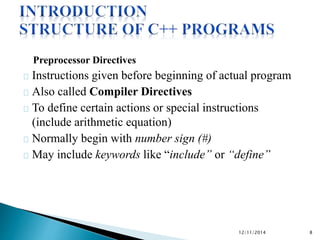

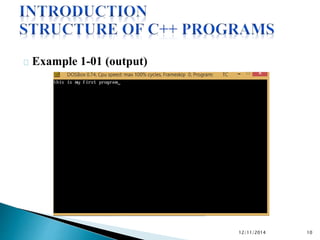


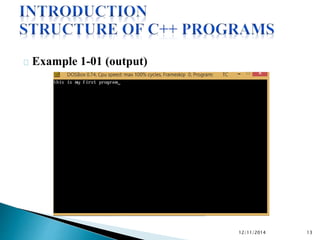

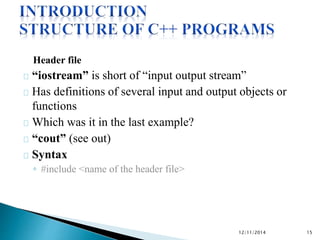








![Example 1-03
#include<iostream.h>
using namespace std;
int main ( )
{
int abc = 4, b = 1997;
float xy = 3.4;
char name[15] = “Marriam Ahmed”;
cout <<name<<endl;
cout<<abc<<endl;
cout<<b<<endl;
cout<<xy<<endl;
return 0;
}
12/11/2014 24](https://image.slidesharecdn.com/cs211module1codeblocksslideshare-141211011523-conversion-gate01/85/Programming-Fundamentals-24-320.jpg)






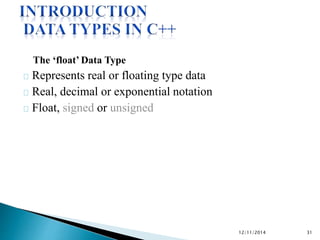

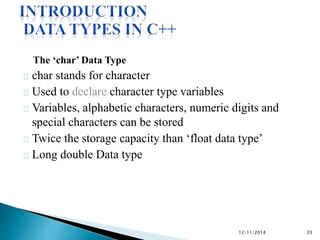

![Declaration of Variables
If not, written in each individual line where each
statement is ended with a ‘;’
Syntax
◦ type list of variables
Example
int a, xy;
Float b;
Char nm [15]
double sum;
12/11/2014 35](https://image.slidesharecdn.com/cs211module1codeblocksslideshare-141211011523-conversion-gate01/85/Programming-Fundamentals-35-320.jpg)

![Example 1-03
#include<iostream.h>
using namespace std;
int main ( )
{
int abc = 4, b = 1997;
float xy = 3.4;
char name[15] = “Marriam Ahmed”;
cout <<name<<endl;
cout<<abc<<endl;
cout<<b<<endl;
cout<<xy<<endl;
return 0;
}
12/11/2014 37](https://image.slidesharecdn.com/cs211module1codeblocksslideshare-141211011523-conversion-gate01/85/Programming-Fundamentals-37-320.jpg)













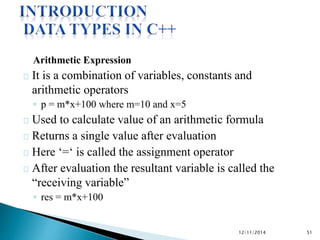


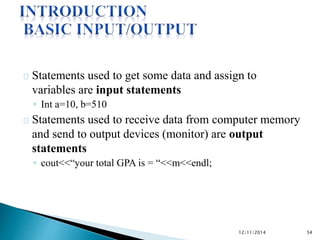

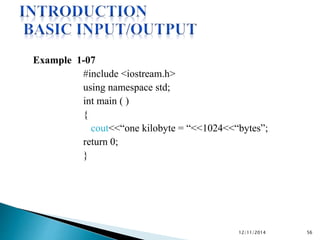
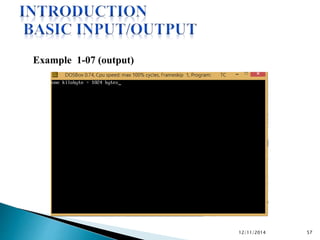



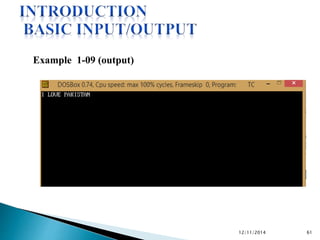
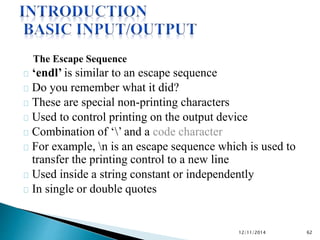
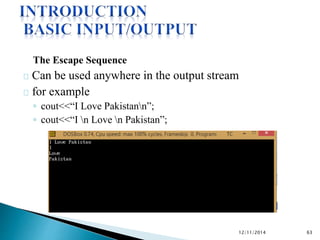


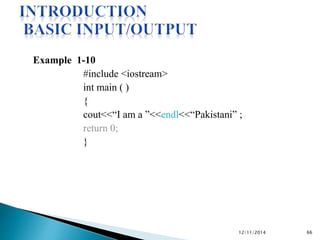



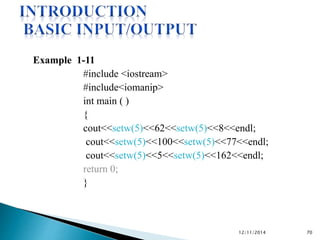

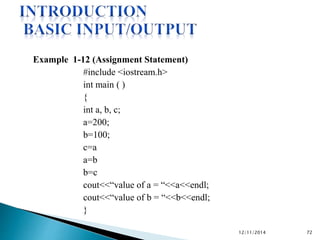



![The “cin” Object— Input Stream
‘cin’ (see-in) stands for console input
This is an input stream
It is a part of iostream header file
It requires you to input from your keyboard during the execution
of a program
Value is input and press Enter to input the value
Syntax
cin>>var1[>>var2….]; >> is an extraction operator or get
from operator
Usually a separate statement is used for each variable
For example
◦ cin>>a>>b>>c; and press Enter to for typing each data
12/11/2014 76](https://image.slidesharecdn.com/cs211module1codeblocksslideshare-141211011523-conversion-gate01/85/Programming-Fundamentals-76-320.jpg)


![Example 1-15
#include <iostream>
{
int age;
long int age_mon;
char name[50];
cout<<“Enter the name of the person “;
cin>>name;
cout<<“Enter the age of person in years “;
cin>>age;
age_mon = age*12;
cout<<“Name of the person = “<<name<<endl;
cout<<“Age in months = “<<age_mon<<endl;
}
12/11/2014 79](https://image.slidesharecdn.com/cs211module1codeblocksslideshare-141211011523-conversion-gate01/85/Programming-Fundamentals-79-320.jpg)

![Example 1-16
float avg;
char name[20];
int total, cpp, os, edp;
cout<<“Enter the name of the student “;
cin>>name;
cout<<“Enter the marks obtained in C++“;
cin>>cpp;
cout<<“Enter the marks obtained in Operating Systems“;
cin>>os;
cout<<“Enter the marks obtained in EDP“;
cin>>edp;
total = cpp+os+edp;
avg = total/3.0;
cout<<“Name of the student = “<<name<<endl;
cout<<“Total Marks = “<<total<<endl;
cout<<“Average Marks = “<<avg<<endl;
12/11/2014 81](https://image.slidesharecdn.com/cs211module1codeblocksslideshare-141211011523-conversion-gate01/85/Programming-Fundamentals-81-320.jpg)



